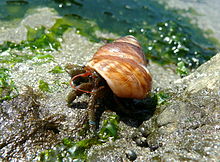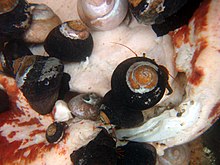| Pagurus samuelis | |
|---|---|

| |
| Pagurus samuelis using a shell of Tegula brunnea | |
| Scientific classification | |
| Domain: | Eukaryota |
| Kingdom: | Animalia |
| Phylum: | Arthropoda |
| Class: | Malacostraca |
| Order: | Decapoda |
| Suborder: | Pleocyemata |
| Infraorder: | Anomura |
| Family: | Paguridae |
| Genus: | Pagurus |
| Species: | P. samuelis |
| Binomial name | |
| Pagurus samuelis (Stimpson, 1857) | |
| Synonyms | |
|
Eupagurus samuelis Stimpson, 1857 | |
Pagurus samuelis, the blueband hermit crab, is a species of hermit crab from the west coast of North America, and the most common hermit crab in California. It is a small species, with distinctive blue bands on its legs. It prefers to live in the shell of the black turban snail, and is a nocturnal scavenger of algae and carrion.
Description
Pagurus samuelis is a small hermit crab, at up to a total length of 40 mm (1.6 in) and a carapace width of up to 19 mm (0.75 in). The base colour of the exoskeleton is brown or green, but the antennae are red, and adults have bright blue bands near the tips of their legs. In smaller individuals, the bands may be white. The legs and carapace are covered in setae, and the rostrum at the front of the carapace is triangular.
Distribution
Pagurus samuelis is found from Alaska to Punta Eugenia in Baja California, Mexico. It was formerly thought to also occur in Japan, but the Japanese specimens which were formerly assigned to this species are now recognised as Pagurus filholi.
Ecology and life cycle

Pagurus samuelis prefers to use the discarded shell of the black turban snail, Tegula funebralis. They are chiefly nocturnal scavengers that feed on algae, especially the giant kelp Macrocystis pyrifera, and detritus. In a laboratory setting, P. samuelis can survive on a diet of Pelvetia canaliculata. Predators of P. samuelis include fishes such as the pile perch (Rhacochilus vacca), California sheephead (Semicossyphus pulcher) and the spotted kelpfish, Gibbonsia elegans.
In the breeding season, males carry females on their backs, sometimes for more than a day. Eggs are produced from May to July, and are carried on the female's abdomen, inside the shell.
See also
References
- Patsy McLaughlin (2010). P. McLaughlin (ed.). "Pagurus samuelis (Stimpson, 1857)". World Paguroidea database. World Register of Marine Species. Retrieved June 20, 2011.
- ^ "Pagurus samuelis – blueband hermit crab". Sanctuary Integrated Monitoring System. National Oceanic and Atmospheric Administration. Archived from the original on March 15, 2012. Retrieved June 20, 2011.
- ^ Edward Flanders Ricketts, Jack Calvin & Joel Walker Hedgpeth (1992). "Protected outer coast". Between Pacific Tides (5th ed.). Stanford University Press. pp. 37–210. ISBN 978-0-8047-2068-7.
- Patsy A. McLaughlin (1976). "A new Japanese hermit crab (Decapoda, Paguridae) resembling Pagurus samuelis (Stimpson)". Crustaceana. 30 (1): 13–26. doi:10.1163/156854076X00341. JSTOR 20102284.
- L. Sandberg & P. A. McLaughlin (1993). "Reexamination of Pagurus minutus Hess, 1865, and Pagurus filholi (de Man, 1887) (Crustacea: Anomura: Paguridae)" (PDF). Zoologische Mededelingen. 67 (13): 197–206.
External links
- Jocelyn Nelson. "Pagurus samuelis (Stimpson 1857)". Marine Biodiversity of British Columbia. LifeDesks. Archived from the original on 2013-04-15.
- J. M. Watanabe (March 11, 2010). "Pagurus samuelis (Stimpson, 1857)". Common Intertidal Organisms of Monterey Bay. Archived from the original on July 20, 2011. Retrieved June 20, 2011.
- Dave Cowles (2005). "Pagurus samuelis (Stimpson, 1857)". Key to Invertebrates Found At or Near The Rosario Beach Marine Laboratory (a campus of Walla Walla University) Fidalgo Island, Anacortes, WA. Walla Walla University. Archived from the original on 2010-11-15. Retrieved 2011-06-20.
- [REDACTED] Media related to Pagurus samuelis at Wikimedia Commons
| Taxon identifiers | |
|---|---|
| Pagurus samuelis | |
| Eupagurus samuelis | |